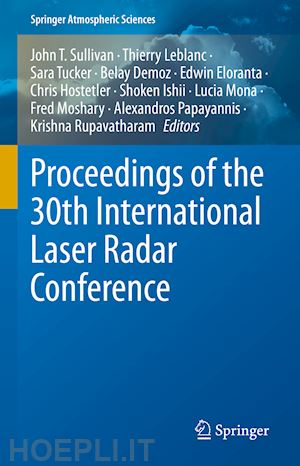

Questo prodotto usufruisce delle SPEDIZIONI GRATIS
selezionando l'opzione Corriere Veloce in fase di ordine.
Pagabile anche con Carta della cultura giovani e del merito, 18App Bonus Cultura e Carta del Docente
This volume presents papers from the biennial International Laser Radar Conference (ILRC), the world’s leading event in the field of atmospheric research using lidar. With growing environmental concerns to address such as air quality deterioration, stratospheric ozone depletion, extreme weather events, and changing climate, the lidar technique has never been as critical as it is today to monitor, alert, and help solve current and emerging problems of this century. The 30th occurrence of the ILRC unveils many of the newest results and discoveries in atmospheric science and laser remote sensing technology. The 30th ILRC conference program included all contemporary ILRC themes, leveraging on both the past events’ legacy and the latest advances in lidar technologies and scientific discoveries, with participation by young scientists particularly encouraged.
This proceedings volume includes a compilation of cutting-edge research on the following themes: new lidar techniques and methodologies; measurement of clouds and aerosol properties; atmospheric temperature, wind, turbulence, and waves; atmospheric boundary layer processes and their role in air quality and climate; greenhouse gases, tracers, and transport in the free troposphere and above; the upper mesosphere and lower thermosphere; synergistic use of multiple instruments and techniques, networks and campaigns; model validation and data assimilation using lidar measurements; space-borne lidar missions, instruments and science; ocean lidar instrumentation, techniques, and retrievals; and past, present and future synergy of heterodyne and direct detection lidar applications. In addition, special sessions celebrated 50 years of lidar atmospheric observations since the first ILRC, comprising review talks followed by a plenary discussion on anticipated future directions.Thierry Leblanc
Dr. Thierry Leblanc obtained his PhD in Atmospheric Physics at University of Pierre et Marie Curie (Paris, France) in 1995. He joined the NASA Jet Propulsion Laboratory in 1996, where he currently leads the Atmospheric Lidar Group. His research over the past two decades has focused on the long-term monitoring of atmospheric composition by lidar in the troposphere and middle atmosphere, more specifically on the evolution (depletion and recovery) of the stratospheric ozone layer, long-term changes in temperature, water vapor, and aerosols in relation to climate variability and change, and changes in air quality. Dr. Leblanc is a member of several international SME groups, including the International Committeefor Laser Atmospheric Studies (ICLAS), the Network for The Detection of Atmospheric Composition Change (NDACC) Steering Committee, and the WMO/GCOS Reference Upper Air Network (GRUAN) Working Group.
Sara Tucker
Dr. Sara Tucker has spent the majority of her career focused on Doppler Wind Lidar (DWL) systems and their applications to atmospheric studies and weather prediction. She received her Ph.D. in 2001 from the University of Colorado where she studied Electrical Engineering with a focus on hybrid optical-digital imaging systems. She worked for Lockheed Martin Coherent Technologies and NOAA Earth Systems Research Laboratory before joining Ball Aerospace in 2010. At Ball, Dr. Tucker works as a Systems Engineering Staff Consultant, providing systems engineering expertise, modelling tools, mentoring, and training for novel space-based lidar mission concepts. She has served as principal investigator for several NASA Earth Science studies to develop and demonstrate DWL technologies for future space-based operation. Dr. Tucker is currently a member of American Meteorological Society Satellite Meteorology, Oceanography, and Climate (SatMOC) committee, Chair of NASA’s Earth Science Advisory Committee (ESAC), a member of the NASA Advisory Council Science Committee (NAC-SC), and a member of the International Committee for Laser Atmospheric Studies (ICLAS).
Belay Demoz
Dr. Belay Demoz holds a doctoral degree in Atmospheric Physics from the University of Nevada and Desert Research Institute in Reno, Nevada. He is the Director of the Joint Center For Earth Systems and Technology (JCET) and professor of physics at UMBC. Prior to UMBC, he was Professor of Physics at the Department of Physics and Astronomy at Howard University, Director of Graduate Studies and Principal PI’s at the Beltsville Research Campus. Before joining academia, Dr. Demoz has worked for the private industry as a NASA contractor, followed bytime as a Civil Servant with. His research interests center on observation and instrumentation in atmospheric physics, dynamics, and climate. He has chaired the Committee for Atmospheric LIDAR Application Studies (CLAS) Committee for the American Meteorological Society, chaired several national and international symposia and conferences and well serves as member and/or Chair of advisory groups for national as well as state agencies and organizations
Edwin Eloranta
Ed Eloranta began working with lidar as a graduate student at the University of Wisconsin in 1966 investigating multiply scattered lidar returns. Since receiving his PhD 1972, he has led a lidar research group at the UW developing meteorological lidar systems to study boundary layers, clouds and aerosols. He was member of the team which constructed the first High Spectral Resolution Lidar and has subsequently worked to make the instrument a robust operational instrument. His research group currently deploysHSRL i











Il sito utilizza cookie ed altri strumenti di tracciamento che raccolgono informazioni dal dispositivo dell’utente. Oltre ai cookie tecnici ed analitici aggregati, strettamente necessari per il funzionamento di questo sito web, previo consenso dell’utente possono essere installati cookie di profilazione e marketing e cookie dei social media. Cliccando su “Accetto tutti i cookie” saranno attivate tutte le categorie di cookie. Per accettare solo deterninate categorie di cookie, cliccare invece su “Impostazioni cookie”. Chiudendo il banner o continuando a navigare saranno installati solo cookie tecnici. Per maggiori dettagli, consultare la Cookie Policy.